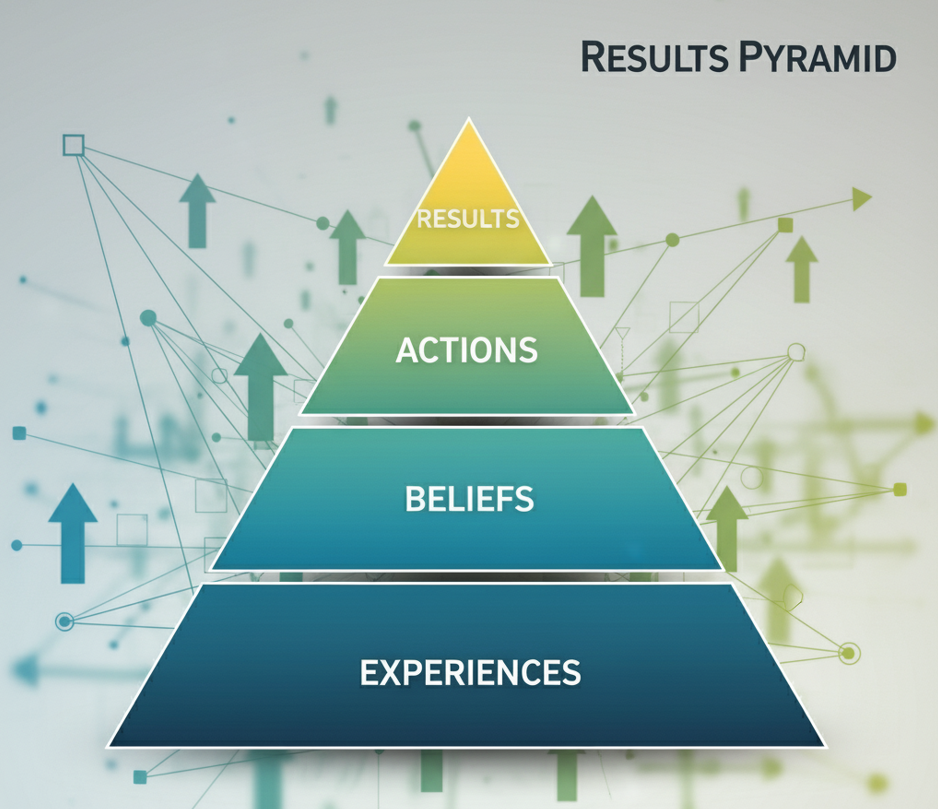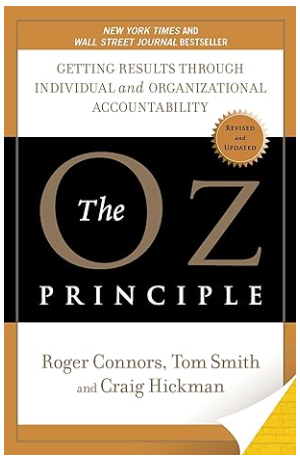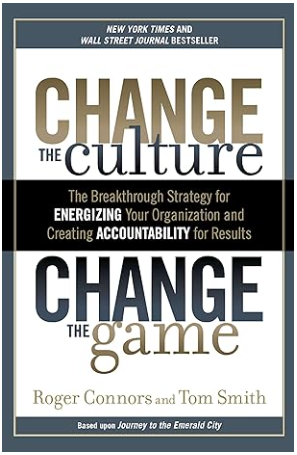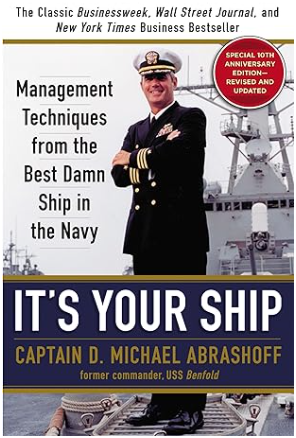As a leader, have you ever felt the frustration of a perfectly crafted strategy falling flat? You set clear goals, outlined the necessary actions, and communicated the plan, yet the needle barely moves. Your team seems busy, but the key results remain elusive. It's a common and maddening experience for entrepreneurs and directors alike. We often respond by pushing harder on the actions—more meetings, stricter KPIs, more check-ins—only to find ourselves stuck in a cycle of diminishing returns.
The problem isn't the work ethic; it's the operating system. We're trying to manage behaviors without understanding the beliefs that drive them. This is where one of the most powerful and enduring frameworks in leadership comes into play: The Results Pyramid®.
Developed by Roger Connors and Tom Smith of Partners In Leadership (now Culture Partners), this model is more than just a theory; it's a diagnostic tool that provides a roadmap for creating sustainable, breakthrough results. The insights in this article are presented from a blended perspective, combining the forward-looking, empowering approach of a certified coach with the experience-based guidance of a mentor. I've seen this framework transform organisations by shifting the focus from "what people do" to "why they do it." It’s time to stop managing the leaves and start watering the roots.
The Genesis of Accountability: A Brief History
The Results Pyramid® didn't emerge in a vacuum. It was born from the foundational work of Connors and Smith in their groundbreaking 1994 book, The Oz Principle. They identified a pervasive tendency in struggling organisations: a culture of victimhood, blame, and excuse-making. They termed this being "Below the Line®." In contrast, successful organisations fostered a culture of ownership and accountability—operating "Above the Line®."
The question that naturally followed was: How do you build an "Above the Line®" culture? Their research led them to a profound insight detailed in Change the Culture, Change the Game. They discovered a clear causal chain that always leads to results, good or bad. This chain is The Results Pyramid®.

It works from the bottom up:
- Experiences: The foundation. These are the realities people see, hear, and feel in the organisation every day. It's how a manager reacts to a mistake, who gets promoted, what gets celebrated, and the stories that are told.
- Beliefs: Experiences foster beliefs. If employees consistently see innovation rewarded (an experience), they will develop the belief that "taking smart risks is valued here." If they see blame passed around after a failure, they will come to believe, "It's safer to keep my head down."
- Actions: Our beliefs dictate our actions. The belief that risk-taking is valued will lead to actions like proposing new ideas and experimenting. The belief that it's safer to be quiet leads to actions of conformity and silence.
- Results: At the peak of the pyramid, our collective actions produce our results—increased revenue, customer loyalty, market share, or conversely, stagnation and decline.
The fundamental mistake most leaders make is trying to manage from the top down. We demand new Results by prescribing new Actions, completely ignoring the Beliefs and Experiences that are actually driving the current, undesirable outcomes.
The Modern Battlefield: Today's Challenges and Opportunities
The principles of The Results Pyramid® are timeless, but their application has become both more critical and more complex in today's business landscape.
Current Challenges:
- The Distributed Workforce: How do you create consistent, culture-shaping experiences when your team is spread across time zones and home offices? The casual interactions, shared celebrations, and observable leadership moments that once formed the bedrock of organisational experience are now fragmented. This makes intentional culture-building a paramount challenge.
- The War for Talent & Quiet Quitting: Employees today aren't just looking for a paycheck; they seek purpose, growth, and alignment. A staggering Gallup report on the global workplace shows that employee engagement remains critically low. This disengagement is a direct outcome of experiences that foster beliefs like, "My work doesn't matter," or "This company doesn't care about my well-being."
- Pace of Change and Burnout: Constant market disruption demands agility. However, forcing new actions ("We need to pivot now!") without addressing the underlying beliefs ("Another flavor-of-the-month change that will fail") leads directly to cynicism and burnout.
Untapped Opportunities:
Despite these hurdles, The Results Pyramid® offers a powerful lens through which to seize modern opportunities.
- Designing Intentional Hybrid Experiences: Instead of lamenting the loss of the old office culture, leaders can now be architects of new experiences. This means designing virtual recognition rituals, creating transparent communication channels that foster trust, and using in-person time for high-value collaborative experiences, not just status updates.
- Building a Culture of Psychological Safety: The foundation of the pyramid—Experiences—is the key to creating what Harvard Business Review champions as psychological safety. When leaders create experiences where it's safe to challenge the status quo, admit mistakes, and be vulnerable, it cultivates the belief that "my voice is valued." This belief unlocks the discretionary effort and innovation needed to thrive.
- Leveraging Data to Understand Beliefs: We now have tools to get a clearer picture of our team's experiences and beliefs. Engagement surveys, sentiment analysis, and performance data, when viewed through the pyramid's framework, can move from being passive metrics to active diagnostic tools, helping you pinpoint the exact experiences that need to change.
The Next Five Years: Future-Proofing Your Leadership
Looking ahead, the principles of The Results Pyramid® will only become more central to effective leadership. Here are three predictions for the next five years:
- Hyper-Personalisation of Employee Experience (EX): Just as companies hyper-personalise the customer experience, they will begin applying the same logic internally. AI and people analytics will enable leaders to understand what specific experiences motivate or discourage individual team members. Leadership will evolve from a one-to-many broadcast model to a one-to-one coaching model, curating experiences that resonate on a personal level to foster powerful, universal beliefs about the organisation's mission. As McKinsey notes, technology is poised to create a more human-centric workplace, if wielded correctly.
- Accountability as a Core Competency: The future of work is decentralised and autonomous. The command-and-control model is dead. In its place, organisations will actively train for "Above the Line®" thinking at all levels. Frameworks like The Results Pyramid® will move from the executive suite to the front lines, becoming a shared language for problem-solving and innovation. The ability to see a problem, own it, and create a better result will become a non-negotiable skill, as critical as technical proficiency. This aligns with the World Economic Forum's view on the top skills for the future, which heavily feature self-efficacy and analytical thinking.
- The Rise of the "Chief Experience Officer": While this title may not be literal for every small business, the function will be essential. Every leader will need to become a "Chief Experience Officer" for their team. The primary role of leadership will be less about directing tasks and more about being a conscious architect of the environment. The most valuable leaders will be those who obsess over the question: "What experience can I create or facilitate today to reinforce the belief we need to win tomorrow?" This is the essence of a thriving coaching culture, and it's where the future of high-performance leadership lies.
Your First Step as an Architect of Results
The Results Pyramid® is not an abstract concept; it's a call to action. It empowers you to stop being a firefighter, constantly reacting to poor actions and results, and to become an architect, intentionally building the foundation for success.
Start small. Look at one key result you're struggling to achieve.
- Instead of asking, "What aren't my people doing?"
- Ask, "What might they believe that is leading to these actions?"
- Then, go deeper and ask the most powerful coaching question of all: "What experience have I—or the company—created that is fostering that belief?"
The answer to that last question is where your true work as a leader begins. By shaping experiences, you shape beliefs. By shaping beliefs, you inspire new actions. And with those new actions, the results you desire won't just be possible; they will be inevitable.
What is the one experience you can create this week to shift a limiting belief on your team?
The Results Pyramid® is a globally registered trademark of Partners in Leadership IP, LLC, an affiliate of Partners in Leadership, LLC d/b/a Culture Partners.
Books to read:
Article written with AI agent support


